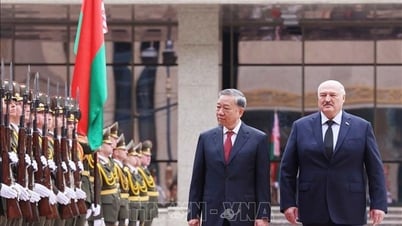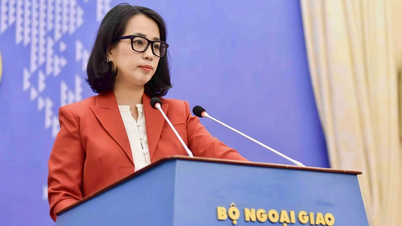 |
| World economic picture from multidimensional perspectives. |
By the end of 2023, reports from many scholars and international organizations mostly concluded that the world economy had “made a soft landing” with different cautious nuances. Forecasts at the end of 2023 were mostly adjusted more positively than in the middle of the year.
Specifically, the European Union (EU) forecasts growth of 3.1%, an increase of 0.3 percentage points compared to the forecast in May 2023; the International Monetary Fund (IMF) forecasts global economic growth of 3.0% in 2023, keeping the forecast in July 2023; Fitch Ratings (FR) forecasts growth of 2.9%, 0.4% higher than the forecast in September 2023; the World Bank (WB) estimates global growth of 2.1% in 2023, keeping the forecast in June 2023.
The world economy has a "soft landing" but still has many potential challenges.
Geopolitical tensions will continue to be a prominent factor in 2023. The conflict between Russia and Ukraine is entering its third year with no signs of ending, while fighting between Israel and Hamas suddenly broke out. Not only causing great loss of life and property, these conflicts also caused fluctuations in financial markets and global commodity prices such as energy and food. This poses risks to growth and inflation, increasing the uncertainty and unpredictability of the world economy.
The US-China rivalry continues to be complex, despite efforts by both sides to improve the situation. In 2023, the prominent issue in US-China relations will be the tense technology war, as both sides fiercely compete for dominance in new technologies such as artificial intelligence, electric cars and clean energy. Many trade restrictions have been introduced by each side to hinder the opponent's progress in these areas.
Factors affecting the world economy in 2024 and the medium term
For 2024, most international organizations forecast global growth to continue to decline and reach a lower level than in 2023. Global growth is currently heavily dependent on the momentum of emerging and developing economies, while over 93% of developed economies will slow down.
The trend of “lost decade” due to weakening growth drivers
According to the World Bank report (March 2023), world economic growth in the next decade will continue to weaken due to the decline of basic driving forces.
The slowdown in manufacturing, a key driver of income and wages, is at its weakest since 2000. Investment, the engine of economic expansion, is growing at only half the rate it did two decades ago.
The global labor force is growing slowly due to aging populations in advanced economies and slowing population growth in many developing economies. International trade is shrinking due to falling global aggregate demand. The Covid-19 pandemic has exacerbated disruptions to education and health, with long-term consequences for potential economic output.
Geopolitical conflicts and tensions continue to be a looming risk.
In 2024, 61% of chief economists believe that the global economy will continue to enter a recessionary trend. Of these, 90% believe that the main cause of global economic instability in 2024 is the impact of geopolitical crises (WEF, 2023). Geopolitical crises have become a serious factor affecting the global economic situation, contributing to instability and uncertainty in the international business environment.
US-China competition is bad for the world economy
Many scholars believe that the US-China strategic competition continues to be a factor that poses many risks to world economic growth.
US-China relations have entered a period of uncertainty, tension and uncontrollability because the two sides do not have a common vision on shaping the cooperative relationship. The two countries have many moves to retaliate against each other, separate markets, supply chains, technology... The trend of over-securitizing economic, trade, scientific and technological relations has led to suspicion and division, creating the risk of fragmenting the international economy, putting other countries under pressure to choose sides.
Risks from the Chinese and European economies
Economists warn that the challenge for China’s economy in 2024 will be a downward trend in growth. “The slowdown in China’s economy is structural, caused by the end of the unprecedented credit and investment expansion of the past decade,” said Logan Wright of Rhodium Group.
Slowing economic growth while consumer prices remain weak in 2023 due to weak aggregate demand is threatening the risk of a deflationary spiral. The long-term overheating of real estate, hit by the shock of Covid-19, has stagnated the market, causing the risk of a bubble bursting. These are dangers to China's economic growth.
UNCTAD warns that concerns about China’s growth prospects have distracted public attention from the risks facing the European economy, which has a global weight similar to China’s (approximately 18% in purchasing power parity terms).
While growth in China is now down about 30% from its pre-Covid-19 average (2015–2019), growth in Europe has fallen by as much as 70% per year. Continued monetary tightening in the euro area risks destabilizing the euro area, which could fall into recession by 2024.
Public debt and fiscal tightening policies of developed countries continue to be challenges for poor countries, hindering the implementation of the 2030 Sustainable Development Goals (SDGs).
Although the world has so far avoided a systemic debt crisis, a development crisis is underway. Many developing countries already had unsustainably high levels of debt before the Covid-19 pandemic. The combination of multiple crises and tight monetary policies in developed countries has worsened the debt situation in developing countries.
Global debt peaked at 257% of GDP in 2020 due to the Covid-19 pandemic, hindering access to resources needed to achieve the 2030 SDGs and climate commitments at COP 21 (Paris, 2015).
Providing public values, digital transformation, reforming financial structures, green and sustainable development continue to be fundamental solutions.
Faced with these challenges, experts say governments need to focus on providing global public goods and services to ensure social security and sustainable development. Biodiversity conservation, environmental protection, strengthening disease prevention measures and promoting international trade are important factors. According to the expert survey, the most effective investment areas will be digital transformation (97% recommended), energy (76%), food (67%) and climate change (67%).
The mechanisms, principles and institutions of global finance need to be reformed to facilitate investment and growth. This mechanism should be based on the participation of all developing countries, jointly agreeing and building procedures, incentive and deterrent policies on the basis of consensus of the parties.
Looking back at 2023, it can be said that there have been positive signs when the world economy basically "landed safely", many bad scenarios did not break out. However, there are still concerns about medium-term difficulties. All recommendations seem to have converged to show the focuses ahead: building peace, maintaining stability; promoting innovation, digital transformation, green and sustainable development; handling debt, increasing support for developing countries to achieve SDGs... What is important is the determination of governments to act with a long-term vision, for sustainable benefits, beyond short-sighted calculations, working together for the future of the world.
Source



![[Photo] Prime Minister Pham Minh Chinh receives Swedish Minister of International Development Cooperation and Foreign Trade](https://vphoto.vietnam.vn/thumb/1200x675/vietnam/resource/IMAGE/2025/5/12/ae50d0bb57584fd1bbe1cd77d9ad6d97)

![[Photo] Prime Minister Pham Minh Chinh works with the Standing Committee of Thai Binh Provincial Party Committee](https://vphoto.vietnam.vn/thumb/1200x675/vietnam/resource/IMAGE/2025/5/12/f514ab990c544e05a446f77bba59c7d1)

![[Photo] Prime Minister Pham Minh Chinh starts construction of vital highway through Thai Binh and Nam Dinh](https://vphoto.vietnam.vn/thumb/1200x675/vietnam/resource/IMAGE/2025/5/12/52d98584ccea4c8dbf7c7f7484433af5)




























































































Comment (0)